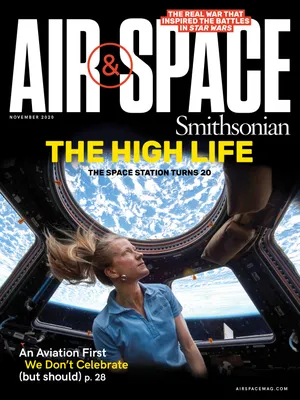Block That Bomb: How Cold Warriors Stopped Nuclear Smuggling
With the dawn of the atomic age came a highly classified operation to intercept nuclear explosives at U.S. airports.
/https://tf-cmsv2-smithsonianmag-media.s3.amazonaws.com/filer/82/69/8269eabd-a9c0-4edc-9e9c-a8a19cdd0352/10g_on2020_gettyimages-515298332_live.jpg)
The number of possible enemies who could smuggle an atomic bomb into the United States has grown from the single Soviet superpower in the 1950s to a sizable handful of states and organizations. Efforts to keep that from happening have remained focused on a single target: weapons-grade uranium. Between 2000 and 2019, the National Nuclear Security Administration reported the disposal or interception of almost 16,000 pounds of that material and plutonium—enough, according to NNSA administrator Lisa Gordon-Hagerty, “for more than 300 nuclear weapons.”
The idea that raw material for one or more of those nuclear devices might be smuggled into the United States is a worry that stretches back to the onset of the cold war and was the topic at a closed hearing of the Senate Special Committee on Atomic Energy on December 5, 1945.
That day, Senator Eugene Millikin of Colorado asked Robert Oppenheimer, who headed the Manhattan Project’s atomic-weapons laboratory, if the United States had radiation detectors able to catch such weapons if they were smuggled across the border. Oppenheimer offered little hope: “The nature of the radioactivity is such that it is not very penetrating, and in many of the designs that I think reasonable the active material would be so thoroughly buried inside a mass of other junk that the evidence [of] radioactivity might be very slight.... If you hired me to walk through the cellars of Washington to see whether there were atomic bombs, I think my most important tool would be a screwdriver to open the crates and look. I think that just walking by, swinging a little gadget, would not give me the information.”
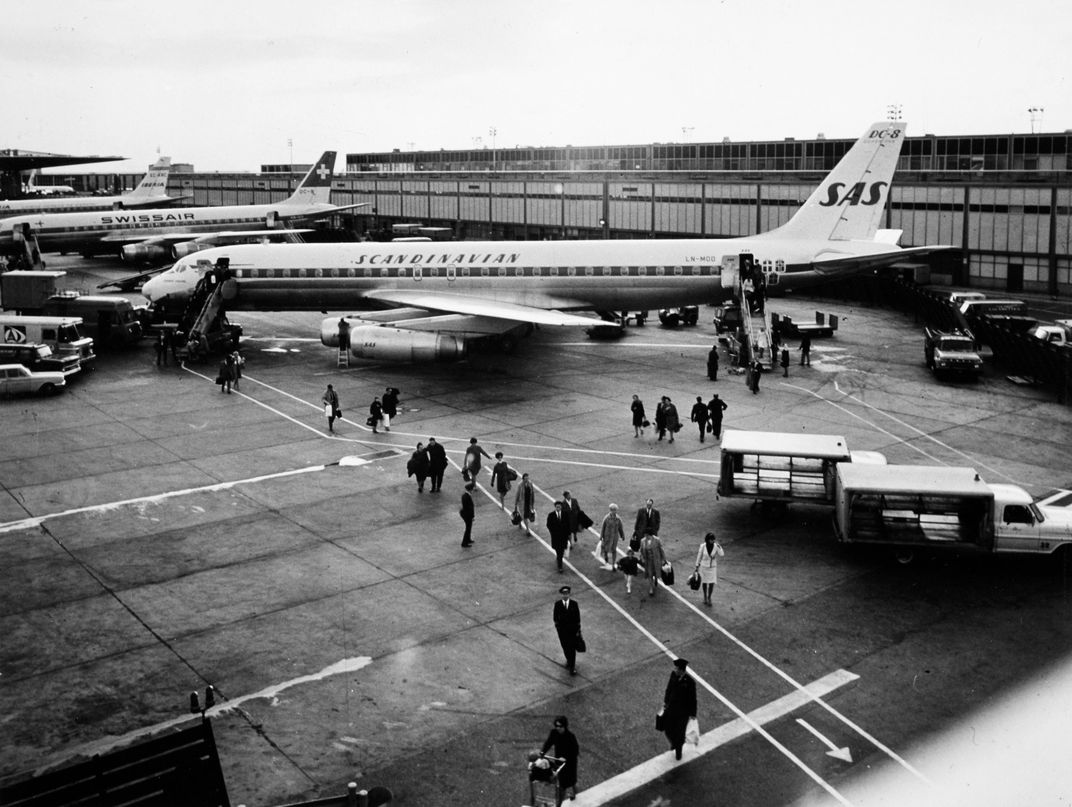
Oppenheimer’s comment about crates and basements took on new relevance after the Soviets exploded their first test bomb in August 1949. The following year, the Truman administration approved Project Screwdriver, which rounded up experts at Los Alamos and Oak Ridge national laboratories to report on the latest A-bomb detection methods. In 1952, Screwdriver led to the invention and installation of a small number of secret radiation detectors mainly at airports in New York and San Antonio, in an operation called Project Doorstop.
All information about Doorstop was highly classified to keep from alerting any bad guys before they could be caught. And despite a few news leaks about the strange new machines, the secret held fast. No details reached the public until a 2010 article in the New York Times, following a freedom-of-information request to the FBI.
Project Doorstop was the first air passenger security-screening effort in history, well before nationally publicized anti-hijacker measures at airport boarding gates. Those later efforts were triggered by the hijacking-to-Cuba craze, which began in 1961 and peaked at a rate of three airliner takeovers every month over the summer of 1969. Because hijackings appeared more of a nuisance than a threat, only a few airports bothered to check passengers for guns and bombs. That changed in November 1972, after three hijackers threatened to drive a Southern Airways DC-9 into a reactor at Oak Ridge National Laboratory. The combination of nuclear energy and airliners so frightened the Nixon administration that it ordered a crash program to take effect at all of the nation’s 500-plus main airports—and in less than two months. The hijacking-prevention program used metal detectors for passengers and X-ray machines for carry-on luggage, with the intent to spot explosives, guns, knives, and grenades.
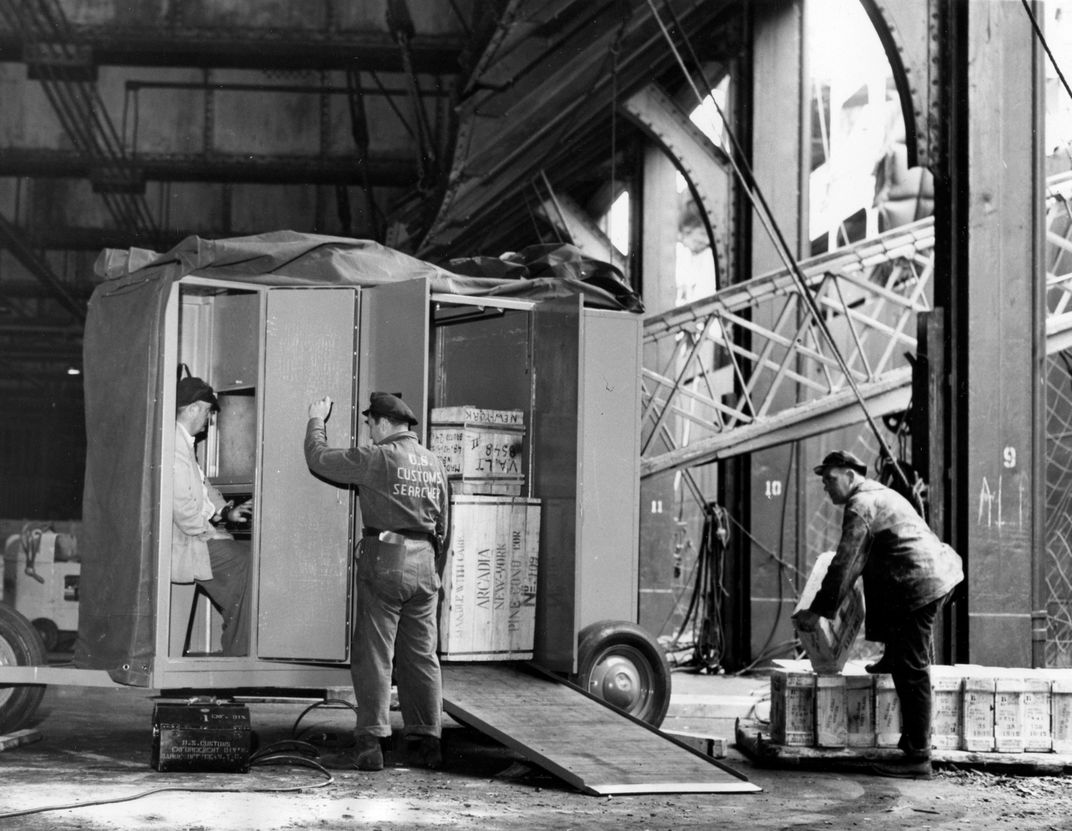
By contrast, Project Doorstop was looking for one thing only: radioactive emissions from a few pounds of uranium or plutonium smuggled by international passengers. The reason was that weapons-grade uranium or plutonium was then (and is now) an essential ingredient for any nuclear bomb, whether a low-yield fission device or city-busting H-bomb.
Doorstop’s radiation scanners began appearing at select locations in August 1954. These came in two sizes: five-foot-long, 800-pound steel cabinets called “passive detectors,” about the size of an office desk, which could screen airline passengers and their luggage; and small, portable, less sensitive units mainly for use by Customs inspectors clambering around ships’ holds.
The Doorstop detectors were placed to catch Soviet A-bomb components before they could reach a destination inside the United States. The reasoning during this pre-ICBM era went as follows: Any successful sneak attack from the Soviets would depend on waves of heavy bombers carrying atomic weapons. Those enemy bombers would betray themselves on North American radar nets, thus preventing tactical surprise. Therefore, American war planners reasoned, it might be tempting for the Reds to plant nuclear weapons inside our cities and air bases, under the control of nearby agents. Those hidden bombs would be triggered just before Soviet aircraft started to show up on radar, greatly hampering American defenses.
While it might seem that a determined enemy would recruit expendable agents and fellow travelers to sneak as many bombs as possible across unguarded stretches of the frontier—the typical plot in smuggled-bomb fiction then and now—that wasn’t the scenario predicted by agencies charged with managing Project Doorstop. One of those agency panels was the Interdepartmental Intelligence Conference, chaired by FBI director J. Edgar Hoover.
After consultations with Soviet hands and war-gamers at the Pentagon, Hoover and his counterparts decided the Soviets would rely on a very small number of tightly controlled, very powerful bombs.

All nuclear detonations must start with small chunks of uranium or plutonium metal brought to a critical mass. While the quantities needed for a workable bomb can be as small as a baseball, the two elements, if left in the open, will betray their presence to radiation detectors with X-ray-like emissions called gamma rays and particles called neutrons. These are products of spontaneous atom-splitting that goes on constantly in weapons-grade uranium and plutonium.
Here is where the problems of A-bomb spotting begin. Gamma rays can be blocked with steel or lead sheets. What about neutron emissions? Neutrons are harder to shield, needing thick layers of water-bearing materials or plastic. Plutonium inevitably sheds huge numbers of neutrons every second. It’s an unavoidable result of its production in nuclear reactors.
The problem the war-planners confronted was that weapons-grade uranium gives off much less radiation than does plutonium. “The good news is that plutonium is far more detectable,” says Penrose Albright, a former director of the Lawrence Livermore National Laboratory. “The bad news is that uranium is not.” Doorstop planners knew that making weapons-grade uranium is a huge industrial challenge, but they also knew the Russians had plenty of it.
To be useful in detecting uranium, Doorstop’s detectors would have to be located within a few feet of passing luggage and passengers. Also, the equipment couldn’t attract attention: If the Soviets figured out what the Americans were doing, they’d just sneak their bombs into the country some other way.
Where to put the big passive detectors? At the outset the Atomic Energy Commission had only six machines available for use by U.S. Customs Service agents. The answer rested on several presumptions. First, the Soviets ran a strictly top-down organization and would never trust smuggled bombs with low-level agents or American sympathizers. The Soviets would take every precaution to keep the authorities from uncovering even one smuggled weapon ahead of an attack. Such a discovery would rock the world and justify an immediate strike on Soviet targets.
Finally, the Doorstop analysts believed that Russian control over detonation timing would be strict. Just a few diplomats could be entrusted with such a grave responsibility: probably only the top officials at the Soviet embassy in Washington and the legation on Park Avenue in New York.
Putting all these presumptions together, the Doorstop leaders thought, the USSR would rely on what would look like the most reliable smuggling method: couriers bringing key bomb components inside sealed diplomatic pouches. (While “pouch” may suggest something no bigger than a polished leather briefcase, it’s just a term of art. Diplomatic pouches can be any size, even a crate big enough to hold a Cadillac.) By international agreement, pouches would be waved through as long as the courier flashed the proper seals and documents.
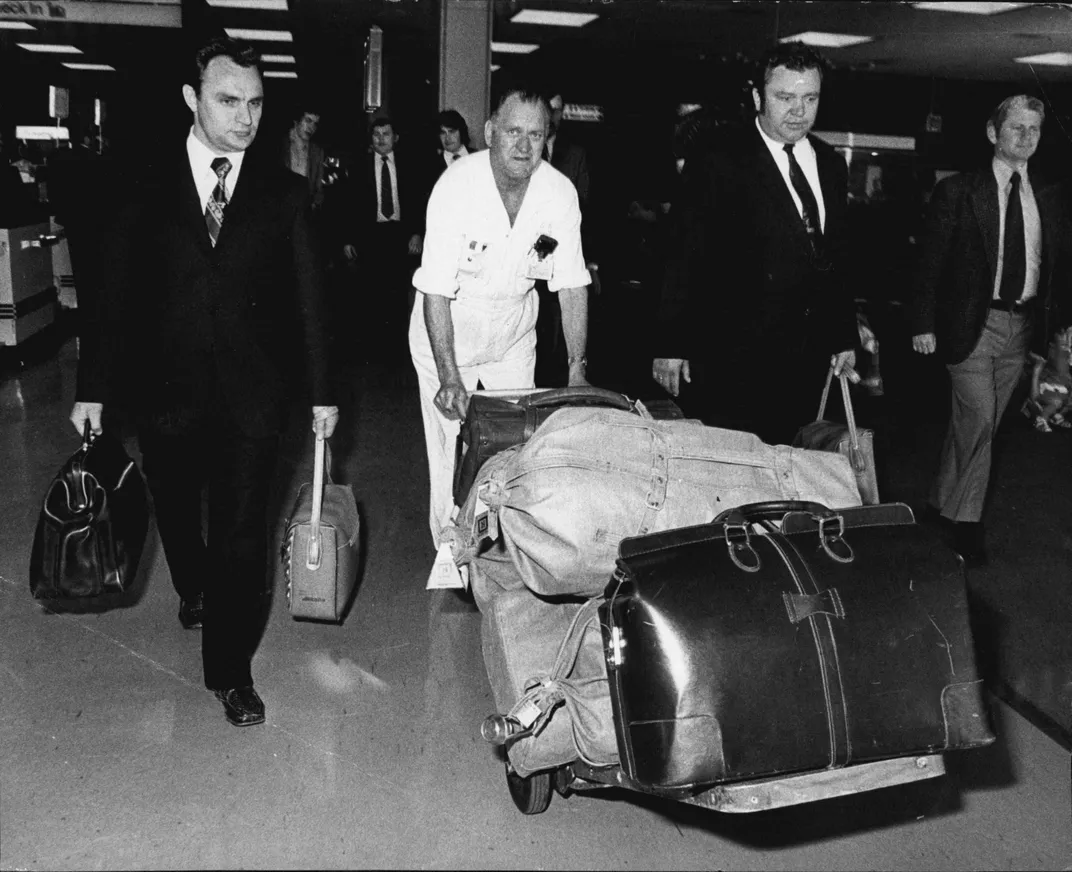
At this time, the United States allowed Soviet-bloc diplomats to use only a few ports of entry. These were in New York, Texas, and Vermont. Of those, the Soviets mostly traipsed through the entries at New York City’s Idlewild Airport and luxury-liner piers on the Hudson. Therefore, Project Doorstop would concentrate five out of its six detectors in New York, for use by trained Customs agents. The sixth would go to the port of entry at San Antonio International Airport.
The first pair of top-secret, desk-size A-bomb detectors attracted no unwanted publicity when installed at Idlewild’s international terminal in mid-August 1954, but the next week was different. Just a day after detectors were plugged in at the inspection sheds of Hudson River Piers 88 and 90, dockworkers sidled up to reporters who had gathered to catch celebrities arriving from the Queen Mary and tipped them off about the mysterious new cabinets. Reporters had more questions the next day after two more luxury liners tied up. U.S. Customs Service and Coast Guard men refused to comment, pointing reporters to nearby FBI agents.
Unable to get any statement other than “men from Washington” were behind whatever this was, a reporter from the New York Times noted that it certainly wasn’t the familiar Inspectoscope, a 14-foot-long X-ray machine kept in the background and used only for baggage toted by suspicious characters. The U.S. Customs Service had been using the Inspectoscope for several years to catch duty-dodging contraband like jewelry and watches. With atomic fears rampant, some reporters speculated that the big gray box might be a new atomic-bomb-nabbing effort.
Hoover was furious at the near-instantaneous security leaks, but publicity trailed off, and the scanners carried on with the job. As far as we know, over 16 years the machines caught no smuggled bombs, but they did flag many other items. The new screening operation took place in the middle of the uranium-mining boom, so samples of the ore from abroad commonly triggered alarms, as did mildly radioactive reels of recording tape and a wide variety of quack medical devices featuring specks of radium. A member of the League of Free Rumanians was taken aside for questioning because he was carrying plastic capsules of “medicinal” radioisotopes for dropping into water glasses.
Despite the lack of concrete results, Hoover was convinced that the Russians were certain to try something, and that Doorstop’s initial efforts wouldn’t suffice to catch them. Foreign sleuthing might help. For more than a year, the FBI, Customs, and Coast Guard chased leads originating from shady informants in Luxembourg and France. These two characters assured the Department of State that the Russians were planning to smuggle eight A-bombs into the United States. Hearing about a suspicious vessel approaching the Eastern seaboard, Coast Guard agents swarmed the Norwegian-flag cargo ship Heina. That turned up nothing more menacing than bales of goat hair from Outer Mongolia. One FBI memo suggested a close look at the owners of the SS Silver Star, a cruise boat that docked in Washington. If a steel-case bomb were attached limpet-style to the hull, no gamma or neutron counter would detect it.
Hoover became furious when he learned that when the gamma or neutron alarm lit up, Customs inspectors did nothing if the luggage was a sealed diplomatic pouch belonging to a card-carrying courier. This followed state department protocol, which said that credentialed diplomats must not be impeded. Whenever a diplomatic pouch set off an alarm, the Customs men could only call the FBI office in New York, give the details, and get an angry earful in return. The FBI would then try to pick up the trail.
Diplomats with mysteriously radioactive material breezed through the dragnet several times, once when a 70-pound pouch carried by an Israeli diplomat triggered both neutron and gamma readings. (The contents are unknown.) Soviet-bloc diplomats set off the alarms at least twice.
Hoover and the FBI had four suggestions to close the loopholes. One was to change the State department rules on diplomatic pouches to ban the passage of any container larger than a business envelope. That way the Soviets would have to slice their uranium or plutonium into wafers and make many dozens of trips through Customs to accumulate enough to make a critical mass, so detection would be more likely. Another was to require inspections of any diplomatic pouch that set off an alarm, or, at the least, to detain an alarm-triggering diplomat long enough to declare him persona non grata. This would send a smuggler and his bags back to the motherland.
The Department of State balked at all of these, arguing that it would cause grievous harm to America’s diplomatic privileges. It also spurned the FBI’s fourth and most ambitious idea—active detection.
The desk-size detectors at the two airports and two docks used “passive” means only. Like a car’s FM radio, a passive device can only receive signals, not transmit them. An “active” detector both receives and transmits some form of radiation. X-ray machines are active detectors: They transmit rays. The rays pass through something of interest and generate an image on the other side.
Hoover, along with the Navy department, argued for active detectors to betray the presence of fissionable materials…by inducing fission. A particle accelerator would generate a stream of neutrons to spray luggage and pouches. If those neutrons hit uranium or plutonium, a burst of gamma rays and neutrons would surely result and betray the secret.
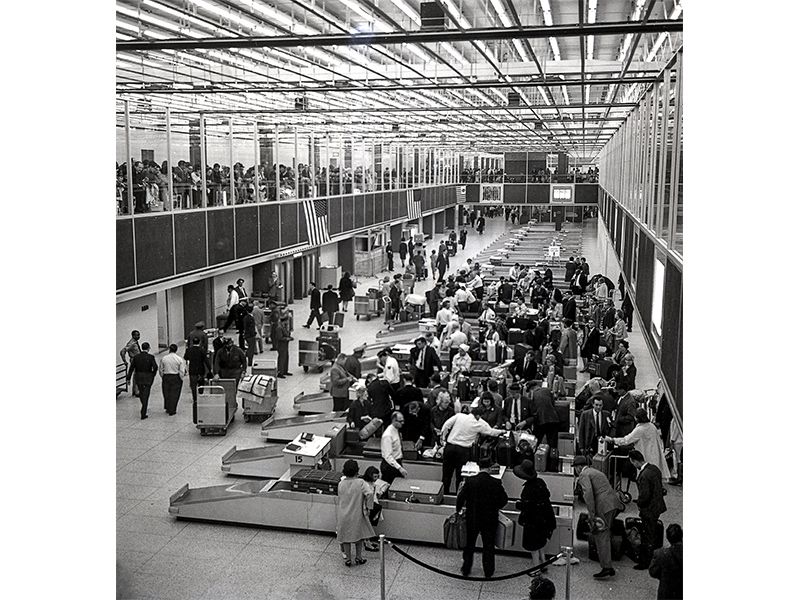
There were problems with this silver bullet. Given the state of 1950s technology, the necessary accelerator would have been 70 feet long. The neutron beam would not only pose a hazard to anyone blundering through it; with time and exposure it could cause some metals (like iron in luggage and cargo containers) to become radioactive in an effect called neutron activation. As far as is known, and despite Hoover’s insistence, Doorstop never installed an active neutron detector to scan passenger baggage.
What legacy did Doorstop leave to airport security? While the early years were (in part) revealed by the 2010 New York Times article, the later years remain classified. The original passive detectors at Idlewild (now JFK) are gone, but in a report dated 2000 the Defense Science Board listed the project as operational through 1970, and according to Albright, some of its radiation detectors may have remained in service into the Clinton administration.
Passive radiation detectors are still the mainstay of nuclear-smuggling interdiction. As with Doorstop’s machines, these emit no hard radiation themselves, only measuring what arrives. Anna Erickson of Georgia Tech’s Woodruff School of Mechanical Engineering, says these machines, both portable and fixed, are numerous and unobtrusive. “You may be standing next to one at an airport or a stadium entrance,” she says. “You wouldn’t know.”
Such machines, which the United States deploys both here and at border crossings in Eastern Europe and other smuggling hotspots around the world, have a purpose beyond catching uranium and plutonium for fission weapons. Considered a more probable risk than these are “dirty bombs” intended to spread a fine cloud of radioactive dust. A few pounds of explosives detonated alongside a canister of stolen cancer-treatment radioisotopes could contaminate many city blocks. While the radiation exposure would be much less than that caused by a fission device, a dirty bomb would still cause enormous distress and economic hardship.
Erickson explained that passive detectors struggle to find nuclear materials for several reasons. Because weapons-grade uranium is a weak emitter of radiation, those emissions can be screened with layers of metal and plastic, particularly if the package lies deep in a large cargo container full of mixed goods. Whatever faint signal leaks out of the container’s steel walls can be extremely difficult to identify because of the low levels of radiation all around us. This ever-present radioactive noise has sources both natural—from cosmic rays and trace elements like radon in the soil and air—and artificial. Kitty litter, fertilizer, abrasives, scrap iron, and even loads of bananas, all of which emit low doses of radiation, have a chance of triggering gamma-ray detectors.
Erickson says that active detection methods, or active interrogation, show real potential to overcome such problems. Neutron generators and particle accelerators are much smaller than in the Doorstop era. A pulse of neutrons or high-energy photons from one of those generators would trigger a brief burst of nuclear fission in any hidden uranium or plutonium. A detector would analyze the wave of fission radiation according to time and energy. One day, it might be possible to scan a passing container ship from a half mile away.
The good news is that, at least as far as garden-variety explosives in luggage go, no airline-checked bag goes unscanned. According to Albright, every one of the millions of wheelies and suitcases loaded aboard U.S. airliners is checked in some mechanical fashion for dangerous contents. Ones that look suspicious in scanned images are pulled aside for hands-on inspection. All of the bag-scanning machines still rely on some form of X-rays, but the methods are more advanced. Many airports rely on computed tomography (CT) machines that use X-ray imaging technology developed for factories and hospitals to produce a three-dimensional image of contents. In conjunction with artificial intelligence (to interpret the images), this technology makes weapon-spotting more accurate and requires much less time for hand inspection.
While the scanning of checked bags and cargo has vastly changed since the first efforts of the 1950s, little has changed in the technology at passenger security checkpoints until recently. After the advent of national airport security checks in 1973—and even after the 9/11 terrorist attacks— security in terminals relied on X-ray machines to peek into carry-on items and on magnetometers to check people for metal objects. These tools have proved inadequate. Undercover federal agents with fake weapons in carry-on bags breezed through, showing a detection rate for banned items that was shockingly low.
New attention to the leakiness of passenger security checkpoints came after nearly successful attempts by would-be suicide bombers to bring on board explosives hidden in, or under, their clothing. Today airports deploy chemical sniffers and the tube-like, hands-over-head portal for passengers called body scanners. The first generation used low-dose X-rays to reveal a good deal more about passengers than contraband. Under pressure from privacy advocates, a newer approach called Advanced Imaging Technology relies on millimeter-wave energy and computer analysis to locate suspicious objects. These items are called out on the agent’s screen as boxes on a generic human figure.
The screening of carry-on bags is also becoming more precise, as the CT scanners already used for checked bags begin to appear in passenger terminals. They have already replaced old-style X-ray machines at several big airports’ security checkpoints, including the American Airlines terminal at JFK Airport—the one called Idlewild that hosted Project Doorstop. Transportation Security Administration director David Pekoske said, in a 2018 CBS interview, that these machines are able to pick out a wider range of explosives as well as smaller amounts of them. He predicts that CT machines may end the need to remove anything from carry-on bags.
At least one holdover from the Doorstop days of atomic anxiety remains in effect: a smuggled-A-bomb bounty law passed in 1955. At the urging of the Department of Justice, Congress authorized payment of up to $500,000 for information leading to the arrest of atomic smugglers. It was amended and renewed under the Ford administration in 1974, and the offer still stands: Point the authorities toward a smuggled nuclear bomb or fissionable materials, and a large cash reward awaits.
